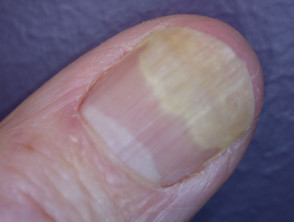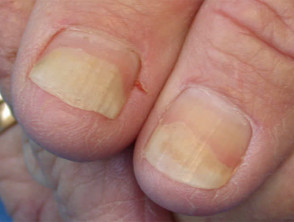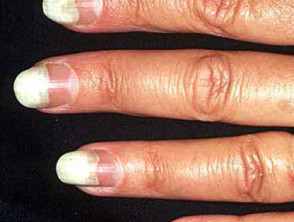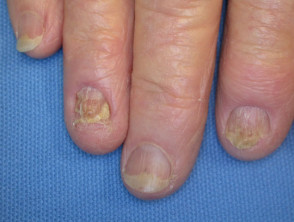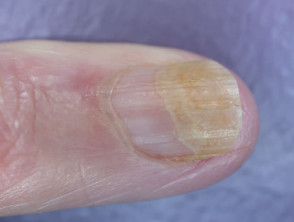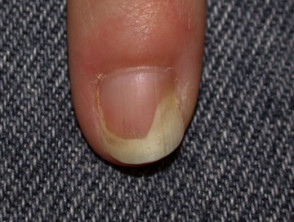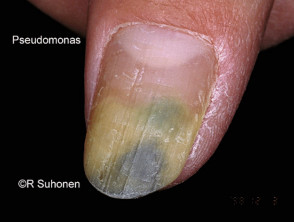What is onycholysis?
Onycholysis is a common nail disorder in which the nail plate has separated from the nailbed typically resulting in a well-defined area of white opaque nail. It may be idiopathic or secondary to trauma, skin disease, nail infections, tumours, or systemic events. Photo-onycholysis is due to ingestion of a photosensitiser, such as a medication [see Drug-induced photosensitivity].
Onycholysis
Who gets onycholysis?
Onycholysis can affect both sexes, all ages and races. It is most frequently seen in adult women.
What causes onycholysis?
Onycholysis can be primary (idiopathic, unknown cause) or secondary to one of many causes. Some examples are listed in Table 1.
| Cause | Examples |
| Traumatic |
Repetitive trauma, including manicure |
| Skin disease | Psoriasis Hand dermatitis Lichen planus |
| Infection | Dermatophytes and yeasts eg, T. rubrum, C. albicans Scabies |
| Systemic disease | Endocrine eg, hypo- and hyperthyroidism, diabetes mellitus, pregnancy Infiltrative eg, amyloidosis, sarcoidosis Malignancy eg, multiple myeloma, Sezary syndrome Photosensitivity eg, porphyrias Yellow nail syndrome |
| Medication | Drug-induced photosensitivity eg, antibiotics including tetracyclines, NSAIDs, psoralens, and oral retinoids Chemotherapeutic agents eg, taxanes |
| Others | Hereditary distal onycholysis (MIM 164800) |
What are the clinical features of onycholysis?
Onycholysis can affect a single nail or multiple fingernails and/or toenails. The distal part of the nail is most commonly affected lifting the free edge; sometimes the nail may detach laterally or proximally. Oil spot sign is an island of onycholysis under a nail.
Clinical features can include the following signs.
- An irregular but sharply defined border between the pink portion of the nail and the white edge of the lifted detached nail.
- The detached nail is usually white and opaque compared to the transparent normal nail that appears pink.
- Lateral/proximal onycholysis and oil spot sign are a yellow-pink colour rather than white.
- The nail surface may be normal or pitted, indented, or crumbly.
- Thickened hyperkeratotic skin may accumulate under the detached nail.
- Subungual haemorrhage can occur in acute-onset onycholysis.
- Onycholysis is usually painless, but may be painful if acute or inflammatory.
Onycholysis in dermatoses
What are the complications of onycholysis?
Onycholysis predisposes to secondary infection under the nail, most commonly with Candida albicans and Pseudomonas aeruginosa, resulting in discolouration of the nail.
Onycholysis can be cosmetically unacceptable, especially for people who work with their hands in public view.
Complications of onycholysis
How is onycholysis diagnosed?
Onycholysis is a clinical diagnosis with the cause often obvious on history and examination. Investigations may be required if the cause is not apparent.
- Nail clippings or scrapings for bacterial and/or fungal culture [see Laboratory tests for bacterial infections, Laboratory tests for fungal infection]
- Blood tests for systemic causes of nail disease, such as thyroid function tests.
What is the differential diagnosis for onycholysis?
Onycholysis may persist or progress due to:
- Continued excessive nail trauma, such as cleaning under the nail with a file
- Continued ingestion of a photosensitising drug, complimentary medicine, or food
- Subungual squamous cell carcinoma
- Melanoma of the nail unit.
Onycholysis should be distinguished from leukonychia (white nail), including Terry nail, in which the nail remains attached but appears white and opaque.
What is the treatment for onycholysis?
The detached portion of the nail will not reattach. The aim of treatment is for the new nail growth to remain attached to the underlying nailbed.
General measures
- Clip the affected portion of the nail and keep the nail(s) short with frequent trimming.
- Minimise activities that traumatise the nail and nailbed.
- Avoid potential irritants such as nail enamel, enamel remover, solvents, and detergents.
- Wear gloves, including light cotton gloves under vinyl gloves for wet work.
- Tape nail to the underlying digit.
- Use of antimicrobial soaks, such as dilute vinegar, to minimise the risk of secondary infection.
Specific measures
Specific treatment of onycholysis depends on the cause. This may mean ceasing or changing a medication, specific treatment of a nail infection, or appropriate treatment for an associated systemic condition or dermatosis.
What is the outcome for onycholysis?
Onycholysis of short duration and of known origin can recover with appropriate treatment. Fingernails take 4–6 months to fully regrow; toenails take twice as long. The longer onycholysis persists the less likely new nail growth will reattach due to permanent damage (cornification) of the underlying nailbed (‘disappearing nailbed’).
